Welcome to our free classical music site

Do you write about classical music? Are you a blogger? Want to team up with Classical Connect? Send us a message, let's talk!

Do you write about classical music? Are you a blogger? Want to team up with Classical Connect? Send us a message, let's talk!
January 12, 2015. Morton Feldman. Last week, as we celebrated Alexander Scriabin’s anniversary, we had to pass over several birthdays, like Nikolai Medtner’s and Francis Poulenc’s. This week is not as rich: many names but few first-rate talents. Ermanno Wolf-Ferrari, born on January 12th of 1876 was considered the best composer of comic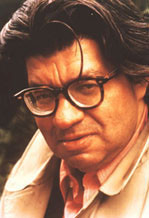 operas of his time; now he’s practically forgotten. Another Italian, Niccolò Piccinni (born on January 16th of 1728), was also a very popular opera composer: he wrote for the Paris Opera and was considered Gluck’s equal. The only problem is that none of his works are staged these days; they’re just not very good. A Russian composer with a very French name, Cesar Cui, was also born this week, on January 18th of 1835. He’s the least interesting of the Mighty Five. Some of his songs are very nice but not much more is performed outside of Russia. The most significant composer of those born this week is the American Morton Feldman. The problem with him is different: in his mature years he wrote enormously long and sometimes difficult compositions and for that reason they are rarely performed.
operas of his time; now he’s practically forgotten. Another Italian, Niccolò Piccinni (born on January 16th of 1728), was also a very popular opera composer: he wrote for the Paris Opera and was considered Gluck’s equal. The only problem is that none of his works are staged these days; they’re just not very good. A Russian composer with a very French name, Cesar Cui, was also born this week, on January 18th of 1835. He’s the least interesting of the Mighty Five. Some of his songs are very nice but not much more is performed outside of Russia. The most significant composer of those born this week is the American Morton Feldman. The problem with him is different: in his mature years he wrote enormously long and sometimes difficult compositions and for that reason they are rarely performed.
Feldman was born on January 12th of 1926 in New York into a family of Russian-Jewish immigrants. As a child he studies piano and then composition; both of his teachers were followers of the New Viennese school of Schoenberg and Webern. When he was 24 Feldman met John Cage and they became fast friends; Feldman even moved into the same building where Cage lived. By then Cage, 14 years older than Feldman, was already well known in the avant-garde circles of New York. Cage introduced Feldman to a number of musicians and painters, such as Cage’s teacher the composer Henry Cowell, Virgil Thompson, George Antheil and Robert Rauschenberg. The 1950s were the golden age of Abstract Expressionism and Feldman became highly influenced by the art of Jackson Pollock, Mark Rothko and, especially, Philip Guston, who was then going through his abstract phase. Years later, in 1984, Feldman would write a four hour-long piece in memory of their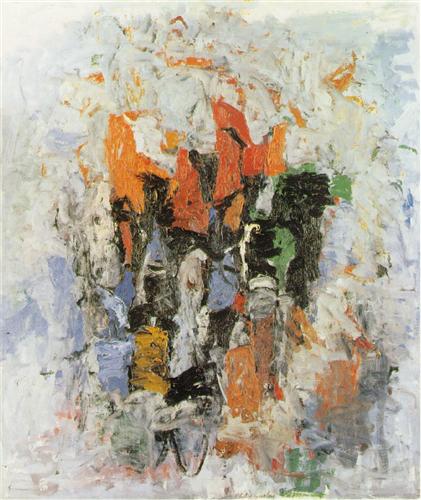 friendship. Called For Philip Guston it’s scored for flute, percussion and piano. The painting “Clock,” on the right, was made by Guston around 1956-57. Of course there’s no clock in sight.
friendship. Called For Philip Guston it’s scored for flute, percussion and piano. The painting “Clock,” on the right, was made by Guston around 1956-57. Of course there’s no clock in sight.
Feldman created a unique graphic system of music notation, within which many things were undetermined and left for performers to interpret. Sometimes it was the pitch, at other times the duration. Somehow, when you listen to his music, the results are always pure Feldman: sparse, whispering, exquisite, atonal but often lyrical, with a tremendous weight given to every sound (or silence), and often insanely long. In 1971 he wrote a piece called Rothko Chapel in memory of his friend Mark Rothko, who committed suicide a year earlier. The chapel, located in Houston, contains 14 large paintings by Rothko. You can listen to Feldman’s tribute to his friend here, it’s performed by members of the Seattle Modern Orchestra. The melody for the viola at the end of the piece was written by Feldman when he was 15. Rothko Chapel is a relatively short piece, it runs for about 24 minutes. Palais de Mari for the piano, written in 1986, was Feldman’s last piano work: he died of cancer on September 3rd, 1987. It’s performed here by Aki Takahashi, a Japanese pianist who premiered several of Feldman’s works. In her interpretation Palais de Mari runs for about 29 minutes.
Permalink
January 5, 2015. Scriabin. Alexander Scriabin was born in Moscow on January 6th of 1872. In 1872 Russia was still using the Julian calendar, and January 6th for those living according to the Gregorian calendar was Christmas Day, December 25th.. Scriabin’s father belonged to a minor Moscow nobility and later in his life would become a prominent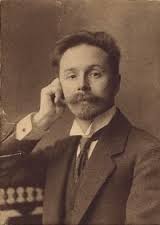 Russian diplomat, his mother was a concert pianist. She died of consumption when Alexander was one year old; she was only 23. Anton Rubinstein, who was for a while his mother’s teacher, took interest in Alexander. By the age of five Scriabin was already playing piano; from an early age he showed interest in composing. He took private lessons with Taneyev and other prominent musicians and later entered the Moscow Conservatory, studying piano with the famous Vasily Safonov, graduating with a gold medal (Sergei Rachmaninov graduated from the Conservatory the same year, also with a gold medal, but of an even higher rank). In 1898 Scriabin was invited to his alma mater as a professor of composition but quit soon after because teaching interfered with his own work. Around this time he became well known as a composer. Scriabin’s early compositions, mostly for the piano, are very pleasant but quite derivative, written in imitation of Chopin’s sonorities: listen, for example, to his Etude in c-sharp minor, op. 2, no. 1 in the performance by Daniil Trifonov (herer). In 1903 Scriabin and his wife Vera, the mother of their four children, left Russia for Switzerland. By then Scriabin was already involved with the 20-year old Tatiana Schloezer. Shortly after the Scriabins legally separated, Schloezer joined Scriabin as his second, common-law wife (they had three more children together; one of them, Julian, who drowned at the age of 11, was a composer who wrote several preludes in the late style of his father). Schloezer, despite her age, was a strong-willed woman who worshiped Scriabin. Some of Scriabin’s friends accepted Schloezer, some refused to do so (Safonov, a former teacher and good friend, stopped talking to Scriabin). The Swiss period marked a significant development in Scriabin’s music. It became highly individual, idiosyncratic. The Fourth and the Fifth Piano sonata and the famous Poem of Ecstasy, which he started in 1905, are great examples of his art of the period (here’s Sonata no. 4 in the F-sharp Major, op. 30, performed by Vassily Primakov). In 1907 Scriabin moved to Paris where for a brief period he got involved with the famous impresario Sergei Diaghilev, and then to Brussels. Short on money (his major Russian patrons cut their funding), he made a trip to New York. Unfortunately, it wasn’t successful. In 1910 Scriabin returned to Russia and stayed there for the few remaining years of his life.
Russian diplomat, his mother was a concert pianist. She died of consumption when Alexander was one year old; she was only 23. Anton Rubinstein, who was for a while his mother’s teacher, took interest in Alexander. By the age of five Scriabin was already playing piano; from an early age he showed interest in composing. He took private lessons with Taneyev and other prominent musicians and later entered the Moscow Conservatory, studying piano with the famous Vasily Safonov, graduating with a gold medal (Sergei Rachmaninov graduated from the Conservatory the same year, also with a gold medal, but of an even higher rank). In 1898 Scriabin was invited to his alma mater as a professor of composition but quit soon after because teaching interfered with his own work. Around this time he became well known as a composer. Scriabin’s early compositions, mostly for the piano, are very pleasant but quite derivative, written in imitation of Chopin’s sonorities: listen, for example, to his Etude in c-sharp minor, op. 2, no. 1 in the performance by Daniil Trifonov (herer). In 1903 Scriabin and his wife Vera, the mother of their four children, left Russia for Switzerland. By then Scriabin was already involved with the 20-year old Tatiana Schloezer. Shortly after the Scriabins legally separated, Schloezer joined Scriabin as his second, common-law wife (they had three more children together; one of them, Julian, who drowned at the age of 11, was a composer who wrote several preludes in the late style of his father). Schloezer, despite her age, was a strong-willed woman who worshiped Scriabin. Some of Scriabin’s friends accepted Schloezer, some refused to do so (Safonov, a former teacher and good friend, stopped talking to Scriabin). The Swiss period marked a significant development in Scriabin’s music. It became highly individual, idiosyncratic. The Fourth and the Fifth Piano sonata and the famous Poem of Ecstasy, which he started in 1905, are great examples of his art of the period (here’s Sonata no. 4 in the F-sharp Major, op. 30, performed by Vassily Primakov). In 1907 Scriabin moved to Paris where for a brief period he got involved with the famous impresario Sergei Diaghilev, and then to Brussels. Short on money (his major Russian patrons cut their funding), he made a trip to New York. Unfortunately, it wasn’t successful. In 1910 Scriabin returned to Russia and stayed there for the few remaining years of his life.
During this time his music evolved even further. Its harmonies grew so complex that the basic tonality became practically irrelevant. Scriabin started talking about his music more in painter’s terms, putting emphasis on such qualities as radiance, sharpness, or brilliancy. Around the same time Scriabin became obsessed with the relationship between color and musical tone. In 1910 he wrote a symphonic poem Prometheus and added a special line to score for the color accompaniment using a special machine called clavier à lumières. He specified that C should be projected in red color, D – yellow, and so on, for all 12 notes of the octave. Only one version of this instrument was ever used, in the performance of Prometheus in New York in 1915.
Scriabin died on April 27th of 1914 of septic shock after a boil on his upper lip got infected as he tried to get rid of it. He was 43. One of the greatest interpreters of his music was the Russian pianist Vladimir Sofronitsky (1901-1961), who married Scriabin’s eldest daughter, Elena. Sofronitsky is not very well known in the West, which is quite unfortunate: some of his recordings were at the highest possible level. Here is the recording made by Sofronitsky of Scriabin’s late Sonata no. 9, op. 68, subtitled “Black Mass.” The recording was made in 1960. We’ll dedicate an entry to the art of Sofronitsky at a later date.
PermalinkDecember 29, 2014. Happy New Year! 2015 is fast approaching, and following yet another serendipitous tradition that was established at Classical Connect over the last several years, we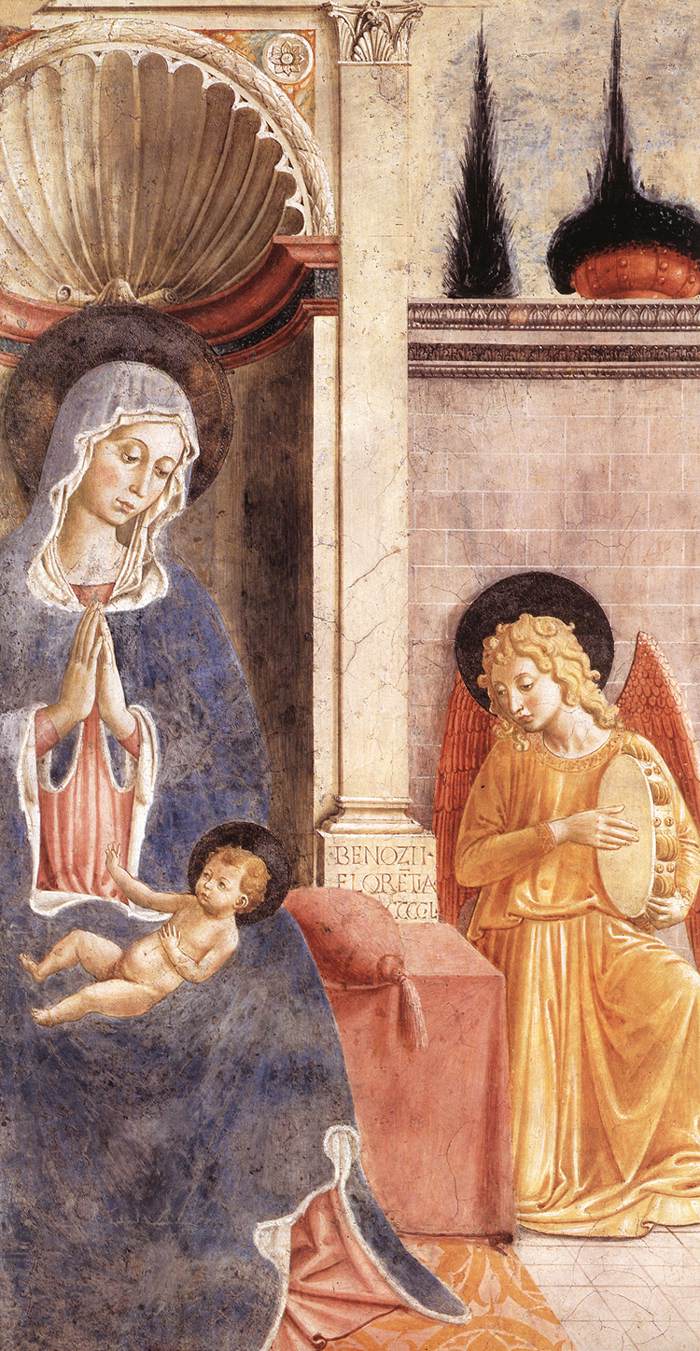 dedicate the last annual entry to a composer with an unknown birthdate. For obvious reason, these composers usually come from the age when record-keeping was not very accurate. During Medieval times not only the birthdate, but often the name and the music itself were usually lost, so our composers come from the period that followed, the Renaissance. Orlando di Lasso (or Orlande de Lassus, as his name is sometimes written) was one such composer. He was born either in 1530 or 1532 in the town of Mons, in the County of Hinaut in what is now Belgium (Gilles Binchois, another famous composer of the Renaissance, was born in Mons 130 years earlier). It is said that as a boy, Orlando had a very beautiful voice – according to a legend he was even kidnapped for it, not once, but three times. When Orlando was 12, Ferrante Gonzaga, of the Mantuan Gozagas, a condottiero close to the Emperor Charles V, heard him sing and made Orlando part of his entourage. Gonzaga’s travels brought Orlando to Italy, Mantua first, then Sicily and Milan. He then moved to Rome, to the household of Cosimo I de’ Medici, the grand duke of Tuscany (despite the title, Cosimo was from a minor branch of the great family that ruled over Florence in the 15th century). He then received a very prestigious position as the maestro di capella at the basilica of Saint John Lateran, the second most important church in Rome (Palestrina would succeed him several years later). He started publishing his music around that time, and in several years became famous not just in Italy, but in all of civilized Europe.
dedicate the last annual entry to a composer with an unknown birthdate. For obvious reason, these composers usually come from the age when record-keeping was not very accurate. During Medieval times not only the birthdate, but often the name and the music itself were usually lost, so our composers come from the period that followed, the Renaissance. Orlando di Lasso (or Orlande de Lassus, as his name is sometimes written) was one such composer. He was born either in 1530 or 1532 in the town of Mons, in the County of Hinaut in what is now Belgium (Gilles Binchois, another famous composer of the Renaissance, was born in Mons 130 years earlier). It is said that as a boy, Orlando had a very beautiful voice – according to a legend he was even kidnapped for it, not once, but three times. When Orlando was 12, Ferrante Gonzaga, of the Mantuan Gozagas, a condottiero close to the Emperor Charles V, heard him sing and made Orlando part of his entourage. Gonzaga’s travels brought Orlando to Italy, Mantua first, then Sicily and Milan. He then moved to Rome, to the household of Cosimo I de’ Medici, the grand duke of Tuscany (despite the title, Cosimo was from a minor branch of the great family that ruled over Florence in the 15th century). He then received a very prestigious position as the maestro di capella at the basilica of Saint John Lateran, the second most important church in Rome (Palestrina would succeed him several years later). He started publishing his music around that time, and in several years became famous not just in Italy, but in all of civilized Europe.
In 1556 Orlando was hired by the court of the Duke of Bavaria. He moved to Munich and remained there for the rest of his life. His fame continued to grow; composers would visit him in Munich, the Pope knighted him, he was invited to many courts. Only Palestrina could compete with Orlando in popularity. He made several visits to Italy, but despite all offers always returned to Bavaria. In his last years his health declined; he died on June 14th of 1594 and was buried in Munich.
Orlando was immensely prolific. Apparently he wrote over 2000 pieces of music, sacred (masses and motets), as well as secular (madrigals and chansons). The cycle of motets called Cantiones sacrae sex vocum (Sacred songs for six voices) was published the year of his death, in 1594. Here are three of these songs: Ad Dominum cum tribularer, Beatus homo, and Cantabant canticum Moysi. They are performed by Collegium Vocale Gent under direction of Philippe Herreweghe. The Madonna and Child (above) are by the Florentine painter Benozzo Gozzoli. It was completed in 1450.Permalink
December 22, 2014. Christmas of 2014. We wish all our listeners a Merry Christmas, a holiday joyous to all music lovers, whether religious or not. We traditionally celebrate it with Johann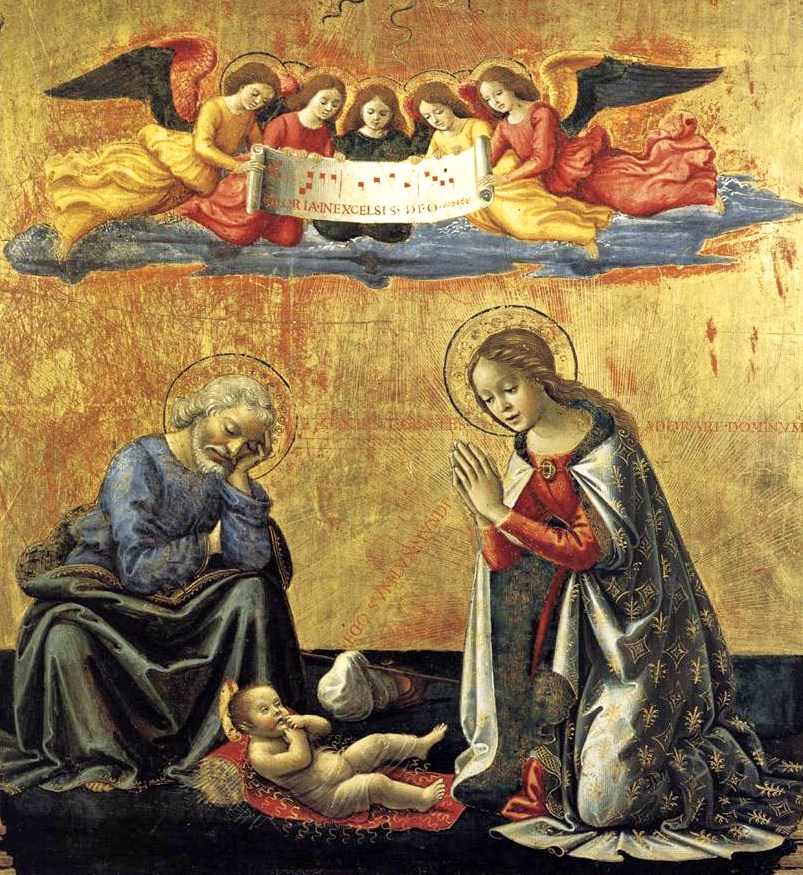 Sebastian Bach’s Christmas Oratorio. A six-part work lasting about three hours, it was written for the Christmas season of 1734, but incorporates several cantatas and other music written earlier. The first part of the cantata describes the birth of Jesus. Here are movements 5 through 9, the final movements of part one. It starts with a Chorale, the tenor recitative of the Evangelist follows, then another Chorale, then a Bass aria and the finale Chorale to the words of Martin Luther. This portion of Christmas Oratorio is performed by the Monteverdi Choir and the English Baroque Soloists under the baton of Sir John Eliot Gardiner. The picture on the left is by the great Italian master Domenico Ghirlandaio. It was painted in 1492 and these days it hangs in the Pinacoteca museum in Vatican. Note that the angels seem to need the sheet music to properly sing Gloria in excelsis Deo -- or maybe they invite us to sing along.Permalink
Sebastian Bach’s Christmas Oratorio. A six-part work lasting about three hours, it was written for the Christmas season of 1734, but incorporates several cantatas and other music written earlier. The first part of the cantata describes the birth of Jesus. Here are movements 5 through 9, the final movements of part one. It starts with a Chorale, the tenor recitative of the Evangelist follows, then another Chorale, then a Bass aria and the finale Chorale to the words of Martin Luther. This portion of Christmas Oratorio is performed by the Monteverdi Choir and the English Baroque Soloists under the baton of Sir John Eliot Gardiner. The picture on the left is by the great Italian master Domenico Ghirlandaio. It was painted in 1492 and these days it hangs in the Pinacoteca museum in Vatican. Note that the angels seem to need the sheet music to properly sing Gloria in excelsis Deo -- or maybe they invite us to sing along.Permalink
December 15, 2014. Beethoven and Kodali. Ludwig van Beethoven was born on December 16th, 1770 – at least that’s the accepted date: no direct record of his birth exists, but we know that he was baptized on the 17th. We celebrate his birthday by going through his piano sonatas. This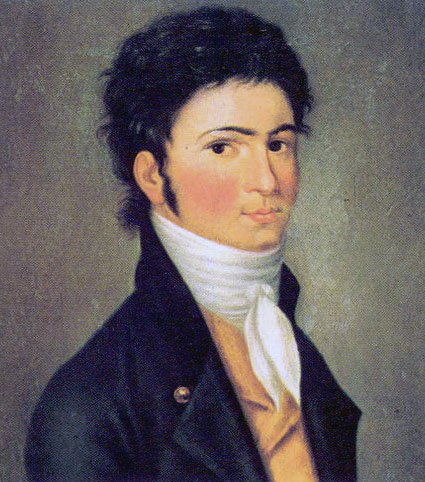 way, even if seemingly arbitrary, is as good as any: Beethoven’s piano sonatas are the not just an essential part of piano literature, they represent a pinnacle of European music. Last year it was Sonatas nos. 2 and 3, op. 2. This year we move on to Sonata no. 4, op. 7, in E-flat Major and the opus 10. Sonata no. 4 was written in 1796. By then Beethoven was living in Vienna (he had moved there from Bonn four years earlier). One of his benefactors, Prince Lichnowsky, provided him with living quarters. Young and cocky, Beethoven was widely acknowledged as a great piano virtuoso. He played in all major salons of the city, often improvising during the concerts. These improvisations brought him great acclaim. He composed, but not as extensively as he would just a couple year later. He also traveled: to Prague, with Lichnovsky, then to Pressburg (now Bratislava). Sonata no. 4 was published in 1797 and was dedicated to Babette Keglevich, Beethoven’s pupil. We know very little about Babette, except that she came from an old noble family, originally from Croatia, and that clearly she was a very good pianist – the sonata is technically quite difficult. It’s also pretty long, running about 28 minutes. Only Hammerklavier, no. 29 Op. 106 is longer. We’ll hear it in the 1975 performance by Sviatoslav Richter.
way, even if seemingly arbitrary, is as good as any: Beethoven’s piano sonatas are the not just an essential part of piano literature, they represent a pinnacle of European music. Last year it was Sonatas nos. 2 and 3, op. 2. This year we move on to Sonata no. 4, op. 7, in E-flat Major and the opus 10. Sonata no. 4 was written in 1796. By then Beethoven was living in Vienna (he had moved there from Bonn four years earlier). One of his benefactors, Prince Lichnowsky, provided him with living quarters. Young and cocky, Beethoven was widely acknowledged as a great piano virtuoso. He played in all major salons of the city, often improvising during the concerts. These improvisations brought him great acclaim. He composed, but not as extensively as he would just a couple year later. He also traveled: to Prague, with Lichnovsky, then to Pressburg (now Bratislava). Sonata no. 4 was published in 1797 and was dedicated to Babette Keglevich, Beethoven’s pupil. We know very little about Babette, except that she came from an old noble family, originally from Croatia, and that clearly she was a very good pianist – the sonata is technically quite difficult. It’s also pretty long, running about 28 minutes. Only Hammerklavier, no. 29 Op. 106 is longer. We’ll hear it in the 1975 performance by Sviatoslav Richter.
The next sonatas, op. 10, were written two years later, in 1798. 1798 was the year that General Bernadotte, the ambassador of the French Directory and the future King of Sweden (as Charles XIV), arrived in Vienna. It’s believed that it was Bernadotte who suggested to Beethoven that he write a symphony dedicated to the young, successful general by the name of Napoleon Bonaparte. Beethoven did write a symphony, his third (we know it as Eroica) and initially dedicated it to Napoleon, but once Napoleon proclaimed himself the emperor of France, Beethoven withdrew the dedication. Opus 10 consists of three sonatas, no. 5 in c minor, in three movements, no. 6 in F Major, also in three movements, and no. 7, in D Major, the largest of the three, in four movements. All three were dedicated to the Countess Anne Margarete von Browne, the wife of count Johann Georg von Browne, an important patron (Beethoven dedicated three string trios op. 9, written at the same time as the sonatas, to the count himself). The sonatas op. 10 are not performed very often, which is a pity: they are beautiful and sound fresh, while the modern concert repertory is often repetitive, with the same pieces being played over and over again. We can listen to sonata no. 5 and no. 6 in the performance by Alfred Brendel; sonata no. 7 is played by Annie Fischer.
Annie Fischer was a Hungarian pianist. She was born in Budapest in 1914. Despite the country’s tragic history, the 20th century saw a flowering of classical music in Hungary. Composers like Béla Bartók, Ernst von Dohnányi (Fischer’s teacher at the Franz Liszt Academy of Music), and later, György Ligeti and György Kurtág were all of the utmost importance. And then there were the conductors: Sir Georg Solti, Antal Doráti, the already-mentioned Dohnányi, Fritz Reiner, George Szell. (It’s interesting to note that most of the musicians we just mentioned were Jewish; most of the Hungarian Jews perished during the Holocaust). One of the most important composers of the first half of the 20th century was Zoltan Kodály, a friend of Béla Bartók. Kodály’s birthday is also this week: he was born on December 16th of 1882. Here’s one of his most popular symphonic pieces: the Háry János Suite from 1926. It’s based on Kodály’s opera, Háry János. The Cleveland Orchestra is conducted by George Szell.
PermalinkJanuary 8, 2014. Messiaen, Berlioz. Two great French composers, Olivier Messiaen and Hector Berlioz (and several others, see below) were born this week. Messiaen was born on December 10th,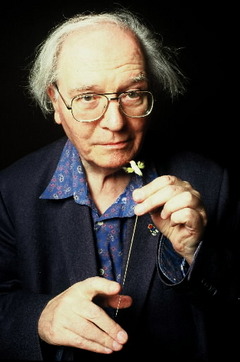 1908 in Avignon. His mother was a poet and his father – an English teacher and translator of Shakespeare into French. Olivier entered the Paris Conservatory at the age of 11 and while there he was awarded several prizes, in harmony and in fugue writing among them. He studied the organ, first with the composer and organist Marcel Dupré and later with Charles-Marie Widor, also a composer and one of the most famous organists of his time. In 1931 Messiaen became the organist of the church de la Sainte-Trinité in the 9th arrondissement, and remained in that position for the following 61 years. Messiaen accepted the Catholic faith at an early age, and many of his compositions were overtly religious. Early in his life (in 1932) he wrote an orchestral piece L'ascension ("The Ascension") and three years later, an organ work titled La Nativité du Seigneur (The Nativity of the Lord). Later in his career, in the 1960s, he wrote La Transfiguration de Notre Seigneur Jésus-Christ ("The Transfiguration of Our Lord Jesus Christ"), a huge work of about one and a half hour’s duration which is scored for the piano, cello and other instrumental solos, a large choir and the orchestra. Later in his life he wrote his only opera, Saint François d'Assise, based on the life of the saint (Messiaen wrote the libretto himself, studying historical sources in the process). One of most interesting pieces in this genre is his piano work Vingt regards sur l'enfant-Jésus (usually translated as “Twenty contemplations on the infant Jesus”). It consists of 20 movements, and we have several in our library. Here is the first movement, Regard du Père ("Contemplation of the Father"), a beautiful, deeply meditative piece, and here – Regard de l'étoile ("Contemplation of the star"), the second movement with its brief celestial motif. Both are performed by the pianist Pierre-Laurent Aimard, who studied with Yvonne Loriod, Messiaen’s second wife. (Aimard is one of the most interesting, highly regarded interpreters of modern music; he recently embarked on a tour playing Book I of Bach’s Well-Tempered Clavier. That, in our opinion, was less successful).
1908 in Avignon. His mother was a poet and his father – an English teacher and translator of Shakespeare into French. Olivier entered the Paris Conservatory at the age of 11 and while there he was awarded several prizes, in harmony and in fugue writing among them. He studied the organ, first with the composer and organist Marcel Dupré and later with Charles-Marie Widor, also a composer and one of the most famous organists of his time. In 1931 Messiaen became the organist of the church de la Sainte-Trinité in the 9th arrondissement, and remained in that position for the following 61 years. Messiaen accepted the Catholic faith at an early age, and many of his compositions were overtly religious. Early in his life (in 1932) he wrote an orchestral piece L'ascension ("The Ascension") and three years later, an organ work titled La Nativité du Seigneur (The Nativity of the Lord). Later in his career, in the 1960s, he wrote La Transfiguration de Notre Seigneur Jésus-Christ ("The Transfiguration of Our Lord Jesus Christ"), a huge work of about one and a half hour’s duration which is scored for the piano, cello and other instrumental solos, a large choir and the orchestra. Later in his life he wrote his only opera, Saint François d'Assise, based on the life of the saint (Messiaen wrote the libretto himself, studying historical sources in the process). One of most interesting pieces in this genre is his piano work Vingt regards sur l'enfant-Jésus (usually translated as “Twenty contemplations on the infant Jesus”). It consists of 20 movements, and we have several in our library. Here is the first movement, Regard du Père ("Contemplation of the Father"), a beautiful, deeply meditative piece, and here – Regard de l'étoile ("Contemplation of the star"), the second movement with its brief celestial motif. Both are performed by the pianist Pierre-Laurent Aimard, who studied with Yvonne Loriod, Messiaen’s second wife. (Aimard is one of the most interesting, highly regarded interpreters of modern music; he recently embarked on a tour playing Book I of Bach’s Well-Tempered Clavier. That, in our opinion, was less successful).
Hector Berlioz was born on December 11th, 1803 in a small town of La Côte-Saint-André in thesoutheast of France. One hundred years apart and completely different in styles, Berlioz and Messiaen have one thing in common: both were absolutely unique, outside of the mainstream music of their time. If you look at the timeline of Berlioz as a composer, it starts in 1830 with the publication of Symphonie fantastique and lasts for the following 30 years, the first half dedicated mostly to symphonic pieces, and the second half – to opera. It coincides with the most creative years of Chopin, Schumann, Mendelssohn in the first half, Wagner and Verdi in the second. Berlioz is unlike any of them. Franz Liszt, who was strongly influenced by Berlioz, is probably the closest to him in all of music literature. In France, Berlioz struggled to be recognized as a composer (Giacomo Meyerbeer was much more popular), even while being praised as a conductor (half a century later, in Vienna, that would also be Mahler’s fate). Symphonie fantastique was premier in December of 1830, and remained in the orchestral repertory ever since. is the second movement, Un Bal, in the performance by the Royal Concertgebouw Orchestra, Sir Colin Davis conducting.
We need to mention two more birthdays, that of Jean Sibelius (December 8th, 1865) and César Franck’s, on December 10th of 1822.Permalink